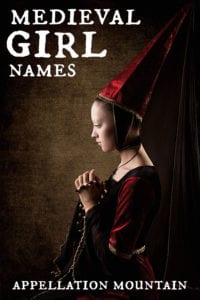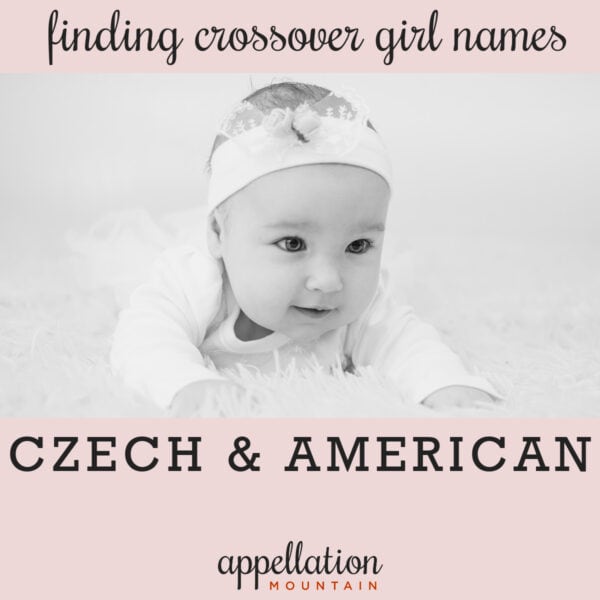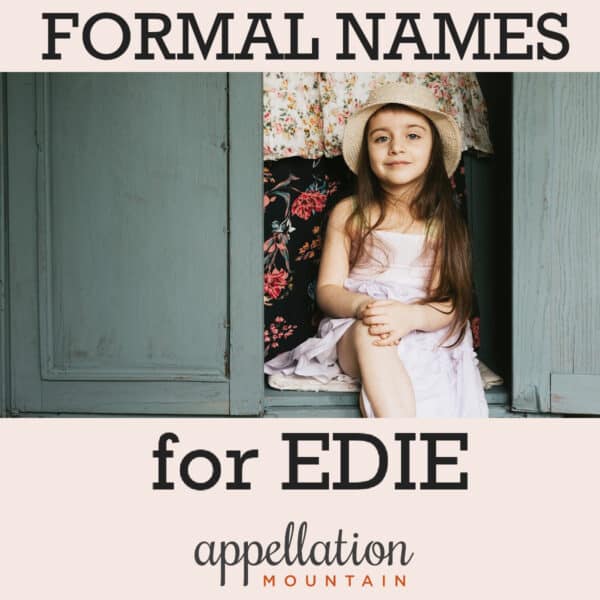
Names change, but also? They stay the same.
Just for fun, let’s imagine that we possess a glorious machine called the Medievalizer. Sounds like a torture device, right? But this machine transforms the most popular choices from our era into medieval girl names.
And if they’re already medieval girl names? Well, it makes them even medieval-er.
It also strives to make them wearable – at least a little – for our time. Amaltrude is legit medieval, but maybe not likely to appeal to parents naming a daughter now.
Of course, this list thrives on a healthy dose of fantasy. Many of these names fit a fictional heroine better than an actual person from the twelfth century. But then, we can’t actually time travel, either.
Enjoy!
ABIGAIL –> AMABEL
This name existed in the Middle Ages, but it sounds more like a contemporary choice – or maybe a Colonial one. Instead of Abigail, how about Ambael? It’s the forerunner of Annabelle and Mabel, and it has a great meaning: loving.
ARIA –> ELISARIA
Musical word name Aria is a twenty-first century favorite, heard in Pretty Little Liars and Game of Thrones. While it’s a modern innovation, the sound exists in several medieval girl names. Elisaria, a mix of Elizabeth and a German element, and spotted in France, seems promising.
AVA and AVERY –> AVEZA
Plenty of Av- names were heard in the Middle Ages, probably derived from the Germanic element avi – desired. As time passed, they became associated with the Latin avis – bird. But that’s a whole other list!
CAMILA –> QUITERIA
A legendary warrior maiden in Virgil’s Aeneid, Camilla persisted in Italian, as well as other European languages, across the centuries. It’s hard to transform it, besides opting for the double-L spelling. Though for something more obscure that sounds medieval-ish, there’s Quiteria. The name of a fifth century saint, it’s originally associated with the goddess Aphrodite.
CHARLOTTE –> CELESTINA
You probably know that the Germanic Carl became the French Charles, leading to feminine form Charlotte. It’s also cousin to Caroline. But none of the feminine forms surface in the Middle Ages – at least not in the records available. Instead, Celestina sounds just different enough to suit, and it was heard – at least in Latin – in the right era.
CHLOE –> CLOTILDE
Once again, the Greek Chloe was not unknown in the Middle Ages. But Clotilde – also spelled Clothilde – feels more at home in the age. Maybe that’s because in the earliest days of the Middle Ages, Clotilde was wife to Clovis I, King of the Franks. She converted her husband – and their countrymen – to Christianity, and is considered a saint.
ELIZABETH –> ELISENDE
Elizabeth works, of course, but for something with that Great Hall vibe, how about Elisende or Elisenda? The name belonged to a fourteenth queen of Aragon, and she inherited it from her mother. It likely has Visigothic roots.
ELLA –> BELLAFLOR
Several of the El- names mentioned on this list might serve, but Ella appeared in some gorgeous compound medieval girl names. Bellaflor (and Florabel) sound like fanciful blasts from the past.
EMILY –> CECILY
Emily requires no alteration, but for something less expected, how about Cecily? Latin records typically recorded the name as Cecilia, but Cecily would’ve been the everyday use form during the Middle Ages. It shares Emily’s rhythm, but feels a little surprising.
EMMA –> EMELISSE
It doesn’t seem logical that Emma would be found among medieval girl names, but it was wildly popular. From the Germanic element ermen, meaning strong, it appeared in at least a dozen compound names. But authentically medieval picks like Ermentrude don’t feel terribly wearable. Instead, how about Emmelise? It appears on this list – and almost nowhere else. Emmeline and Emmelina would be safer bets, but Emelisse intrigues.
EVELYN –> AVELINA
Another avi name, Avelina came from Avila – desired. It was whispered down the alley into Evelyn over the year. Now Evelyn seems like the traditional choice, and Avelina the gussied-up innovation.
GRACE –> GRACIA
Grace names proved popular in the Middle Ages, and they remain so today. But while Grace tops contemporary charts, we’ve almost forgotten some lovely rarities. Gratiana comes from the Latin word gratus. There’s also Gratiosa. Though perhaps Gracia is the most accessible of them all.
HARPER –> HILDEGARD
Some medieval girl names are reached with minor transformation. But Harper, a surname name boosted by a twentieth century novelist, requires more significant renovation. Hildegard retains the first initial, but it also feels tailored and strong. It might be my favorite transformation on the list.
ISABELLA –> ISABEAU
No question that Isabel and Isabella would’ve been right at home in the Middle Ages. But for something on the throwback side, how about Isabeau? It’s another form of the name, one that’s mostly forgotten now. Fans of A Discovery of Witches might think of Ysabeau, the vampire matriarch of the de Clermont family. Other elegant options from the right age include Isolde, Idonia, and Belsante.
LEAH –> LELLA
In medieval Italy, any name ending in Ella might be shortened to Lella. It has the same breezy, brief sound of Leah. Of course, Leah also has Biblical status and a long history of use. If that’s a consideration, names like Leticia and Leolina might appeal.
LILY –> FLORENCIA
For sound, the lovely Lily probably becomes Lella, too. And Lily almost certainly existed in the Middle Ages – but as a nickname for Elizabeth. (Yup. Lillian came later.) But if it’s the floral vibe that charms, then Florencia might be a better bet. A few botanical names, like Eglantine – sweet brier – also were in use. So was Susanna, which literally means Lily. But Florencia might strike the best balance between being an throwback to the year 1200, as well as a name at home today.
LUNA –> LUCERIA and LUCINA
Lu and Lou names abound. Lucida comes directly from the Latin lucidus – clear, shining. Lucina sounds like a diminutive form of Lucia, and maybe it sometimes was. But there’s also a Roman title Lucina, applied to both Juno and Diana. It was associated with childbirth, as well as the moon. That last part takes us full circle to Luna – and makes Lucina a great medieval version of the name.
MADISON –> MATILDA and MAUDE
Matilda might strike you as Australian. Or bring to mind the Roald Dahl character. But long before we waltzed or met the Wormwood family, Matilda of Flanders was the wife of William the Conqueror. They (probably) named one of their daughters Matilda, too. As for Maude, it sounds like a different name, but it’s actually cousin to Matilda, used interchangeably to refer to women by the name throughout the Middle Ages.
MIA and MILA –> IDA and MILLICENT
If a short, compact name appeals, then Ida steps in for modern minis like Mia and Mila. But sound might also suggest Millicent. Another Germanic name with a no-nonsense meaning – work and strong – Millicent is familiar, but rare, in this century.
OLIVIA –> ORIANA
Olivia comes from Shakespeare, so it’s only fitting that another literary invention substitute. Oriana appeared in the fourteenth century romance Amadis of Gaul. In the tale, Oriana is heir to the British throne. It was sometimes used to refer to Queen Elizabeth I, as in The Triumphs of Oriana, a collection of madrigals celebrating her reign. It means golden.
PENELOPE –> PETRONELLA
Another long and elaborate P name, Petronella substitutes nicely for Penelope. Petronella or Petronilla come from Petronius, an old Roman family name. It’s as elaborate as Antonella or Isabella, but rare enough to feel nicely old school.
SCARLETT –> SIBYL
Maybe some medieval girl names mean red, and could work here every bit as well. But for style and sound, Sybil feels like a perfect alternative. The spelling Sybil has fared better in recent centuries, but it’s so uncommon than either works well.
SOFIA and SOPHIA –> SAFIRA, SAPHIRA, and SAPPHIRA
You might stick with Sophia, but medieval girl names starting with S abound. Sapphira, borrowed from the New Testament, is a favorite. Sabina and Sidonie also replace Sophia/Sofia nicely.
VICTORIA –> VALASCA
Plenty of V medieval girl names exist, but let’s end with something truly obscure. In Bohemian legend, Valasca was a tougher-than-tough warrior woman, pledged to protect the princess Libussa. (The princess would go on to, among other things, found Prague.) It’s quirky, obscure, strong, and yes, medieval.
SOURCES
The original version of this post relied on the extensive lists at the Medieval Names Archive, Kate Monk’s Onomastikon, and The Middle Ages. The Dictionary of Medieval Names from European Sources proved the biggest resource for the 2020 revision. It’s marvelous, and you should absolutely check it out!
First published on January 20, 2012, this post was revised substantially and re-published on August 1, 2020.





I’m loving the throw back names 🙂 Elysande, Matilda, Isabeau & Aleydis are wonderful!
More suggestions:
Sophia/Sofia….Sophronia
Nevaeh….Would Mattea be found in the middle ages?
make that Niamh
How about Agnes for Abigail? And Heloise or Helena for Hailey?
There was an Ailith in a novel I read last year. The character was horrible, but I couldn’t get over how stunning the name was.
Any chance we could get a Fetching Names in the vein of the Hermiones, but for boys? I’m always falling in love with the girls names, but I struggle with the boys… so of course we’re expecting a little guy in July. 🙂
Agnes was my thought too, possibly Agatha? Angharad?
Niamv for Neveah
Wow, let me think about Hermiones for boys – that’s a fun challenge!
*sigh* I love medieval names. The obscurer the better. Aidric, Merewen and Endelyn are some of my longstanding favourites. I also have a think for the Mel- and Adel- names.
Ottilie for Natalie?
Genius. Of course!
I love Ottilie. I wish it was a little more familiar to people. I’m not sure they would get it. I like the nickname Lottie for it. Natalie really doesn’t do anything for me though. I think it’s the Nat.
I’m intrigued by Mabley. Sounds modern but I love the fact that it has deep routes 🙂 Definitely one for my list.
I haven’t found a good explanation of why this happened, but SO many names that were recorded with a Latinate -a ending were actually used with a -y ending. Cecilia/Cecily, for example. Mabley – one that I love, too! – would’ve come out of the Amabel family, but I’m not exactly sure how.
I’m not so sure you’re right about Leah. It’s an ancient Biblical name and has been in circulation, at least by Jewish families, for hundreds of years.
– a Leah
You know, you might be right. I don’t see her in the few records of Jewish women’s names from the Middle Ages that I’ve found … but then, there just aren’t that many records. I do see Rachel and Esther, as well as a bunch of variations on Miriam. It may have been used been relatively uncommon – or used but just in places where the written record is limited.
I keep getting smacked in the face by Belsante. It’s like she OS calling out to me ‘use me, use me’. I may just have to use her.
My sister Maddy’s best friends name is Sabine. I think it is a lovely name.
Elysande, Aelis and Amabel strike me as unusual but perfectly wearable.
You’d find a Nicola? I’m pretty sure that was male in origin (still is today).
From the list I liked Havisa, Leticia, Lilias, Adela, Oriana and Sapphira the most. I actually prefer Sapphira or Safira more than Sapphire.
Like many names, Nicola is legitimately gender neutral – has been for ages. Nicola is masculine in Italian and Nikola can be found in several Slavic languages. But Nicola also developed as a feminine form of Nicholas in many languages – Latin, for one, but also German and several Slavic languages. It certainly wasn’t a common name for women, but it does appear in the record. (Unlike Nevaeh – though who knows? There might be something similar out there that I didn’t find …)
The tricky thing, of course, is that many people probably had their names recorded only a time or two, and the name recorded wasn’t necessarily as it would have been used in the vernacular. We find Amicia recorded, but Amice or Amy was probably what the woman would’ve considered her name … So, no, Nicola isn’t an exclusively masculine name that has been stolen, but it wasn’t common, either. Then again, Nicholas has fared best in English in very recent decades, so that’s another factor to consider.
In the Middle Ages, it was common for girls to be given boys name (not a new phenomenon), but when their names were recorded in documents, as Latin was used, the Latin feminine was employed. Thus a woman called Nicola in a Latin doc would almost certainly have gone by Nicholas — which was still found as a girl’s name in Scotland as late as the nineteenth century. Same is true for most medieval Alexandras, Philippas, etc. Queen Philippa of Hainault, for instance, is referred to as “Philip” in contemporary English language documents.
I’ve loved Cecily for a while now, but I’m adding Belsante, Simona, and Ismay to my list!
I love Aldith, Annora, Rohese, Peronel, & Gytha.
It’s not quite my style, but I’m surprised Tacey hasn’t made a comeback–it just sounds so modern!